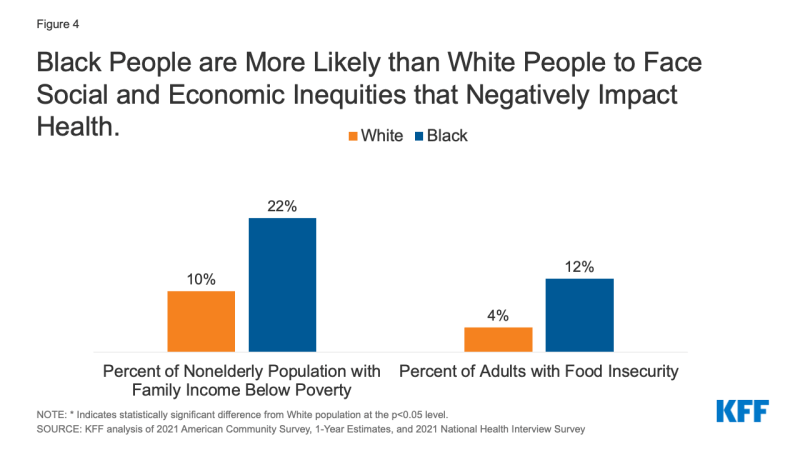How Recognizing Health Disparities for Black People is Important for Change

[ad_1]
February 1st marked the beginning of Black History Month. The 2023 theme for Black History Month is Black Resistance, an exploration of how African Americans have nurtured and protected Black lives, and fought against historic and current racial inequality. In fact, while Black people have made great contributions and achievements in the United States, they continue to face many health and health care disparities that adversely impact their overall health and well-being. These disparities have been exacerbated by the uneven impacts of the COVID-pandemic, ongoing racism and discrimination, and police violence against and killings of Black people. Moreover, the long history of inequitable health outcomes among Black people reflects the abuses faced during slavery, segregation, mass incarceration and their persistent legacies.
Black people make up 12% of the population in the United State as of 2021 (Figure 1). The Black population has grown has grown by nearly 30% since 2000, with the increase in foreign born Black people playing a significant role in this growth. As the population has grown, it has become more diverse, with an increase in the share of Black people who identify as multiracial and/or Hispanic.
Black people face increased barriers to accessing and utilizing health care. Black people are more likely to report financial barriers to receiving health care (Figure 2). While the implementation of the Affordable Care Act and pandemic-era policies have helped narrow some disparities in health coverage, nonelderly Black people (11%) continue to have a higher uninsured rate than their White peers (7%) (Figure 3). Further, compared to White people, Black people are more likely to face social and economic challenges that adversely impact health, including higher rates of poverty and food insecurity (Figure 4). Black adults are also more likely than White adults and to report being treated unfairly because of their race/ethnicity while seeking care for themselves or family members (Figure 5).

Figure 4: Black People are More Likely than White People to Face Social and Economic Inequities that Negatively Impact Health
Reflecting these inequities, Black people report having worse health outcomes compared to White people. At birth, Black people have shorter life expectancies compared to White people (70.8 vs. 76.4 years), and they experienced a larger decline in life expectancy than White people between 2019 and 2021, with it falling by 4.0 years. (Figure 6). Black people have the highest rates of infant mortality (Figure 7) and maternal mortality (Figure 8) across all racial and ethnic groups for which data were available and experienced the largest increase in maternal mortality when compared to pre-pandemic levels (Figure 8). Although Black people fare better than White people for some cancer screening and cancer incidence measures, they have higher rates of cancer mortality (Figure 9). The underlying inequities in health and health care for Black people also contributed to disparities in COVID-19, with Black people facing a higher risk of hospitalization and death due to COVID-19 compared with White people. Moreover, the disparate effects of COVID-19 may lead to widening disparities in health going forward.
Ongoing racism and discrimination, police violence against and killings of Black people, and gun violence also negatively impact health and well-being of Black people. Black people’s repeated and chronic exposure to stressors associated with racism and discrimination drive rapid biological aging and poorer health outcomes. Black people are more than three times as likely to be killed by police than White people, and over the course of a lifetime 1 in every 1,000 Black men can expect to be killed by the police. This exposure to police violence has been found to have negative mental health outcomes for Black people. Black youth have also been disproportionately affected by gun violence, which can adversely affect the mental health and well-being of children. Data show that firearm death rates sharply increased among Black youth during the pandemic, largely due to gun assaults and suicides by firearm (Figure 10). While overall rates of mental illness and substance use disorder are lower for Black people compared to White people, they may be underdiagnosed among people of color. Data also point to increasing mental health needs as Black people have experienced a faster rise in deaths by suicide and drug overdose deaths compared to White people (Figures 11 and 12). These findings highlight the importance of addressing mental health needs among the Black population and reducing barriers to treatment.
In line with this year’s Black History Month theme, resisting health inequities by addressing the historic and current health and social challenges faced by Black people will be key to achieving health equity. As the Black population continues to grow and become more diverse, improving their overall health and well-being will support the overall health and prosperity of the United States.
[ad_2]
Source link
